Milling Microchannels in Monel 400 Alloy by Wire EDM: An Experimental Analysis
Abstract
1. Introduction
2. Materials and Methods
3. Results and Discussion
3.1. Parametric Influence on Machining Speed (MS)
3.2. Parametric Influence on Microchannels Width (CHW) and Depth (CHD)
3.3. Parametric Influence on Surface Roughness (Sa, Sq and Sz)
3.4. Surface Morphology
3.5. Microhardness Analysis
3.6. Microstructure Analysis of Recast Layer
4. Conclusions
- The microchannel width is significantly affected by pulse-on time and average gap voltage. An increase in pulse-on time and average gap voltage leads to an increase in the microchannel width. Dielectric flow rate has a small effect on microchannel width, in which an increase in flow rate leads to a slight increase in microchannel width.
- The microchannel depth is mainly affected by pulse-on time, average gap voltage and dielectric flow rate. An increase in pulse-on time and average gap voltage leads to an increase in the microchannel depth while increasing the flow rate decrease the microchannel depth.
- Machining speed is increased significantly with increasing pulse-on time and decreased with increasing in pulse-off time and average gap voltage.
- Surface roughness characteristics (Sa, Sq and Sz) are mainly affected by pulse-on time, pulse-off time, average gap voltage and dielectric flow rate. Surface roughness parameters increase with an increase in pulse-on time and dielectric flow rate and decrease with an increase in average gap voltage and pulse-off time.
- The surface morphology is profoundly affected by the pulse-on time, pulse-off time and average gap voltage. A smoother surface with reduced occurrences of craters, holes, globules and redeposited materials could be achieved by employing low pulse-on time, high pulse-off time and high average gap voltage.
- Reduction in the microhardness beneath the machined surface was found to be the inherent characteristics of the WEDM process due to the presence of the recast layer and annealed heat-affected zone. The extent of the heat-affected zone was found to be in the range of 40 to 50 µm below the machined surface.
- Microstructure analysis of the recast layer revealed an increase in the thickness of the recast layer with an increase in pulse-on time and a decrease in pulse-off time and average gap voltage. The maximum recast layer thickness was limited to 2.55 µm.
Author Contributions
Funding
Conflicts of Interest
References
- Ventrella, V.A.; Rossi, W. De Micro Welding of Ni-based Alloy Monel 400 Thin Foil by Pulsed Nd: YAG laser. Phys. Procedia 2011, 12, 347–354. [Google Scholar] [CrossRef]
- Patil, D.H.; Mudigonda, S. Investigation on effect of grain orientation in photochemical machining of Monel 400. Mater. Manuf. Process. 2017, 32, 1831–1837. [Google Scholar] [CrossRef]
- Parida, A.K.; Maity, K. Experimental investigation on tool life and chip morphology in hot machining of Monel-400. Eng. Sci. Technol. Int. J. 2018, 21, 371–379. [Google Scholar] [CrossRef]
- Thakur, A.; Gangopadhyay, S. State-of-the-art in surface integrity in machining of nickel-based super alloys. Int. J. Mach. Tools Manuf. 2016, 100, 25–54. [Google Scholar] [CrossRef]
- Patil, D.H.; Mudigonda, S. The Effect of the Rolling Direction, Temperature, and Etching Time on the Photochemical Machining of Monel 400 Microchannels. Adv. Mater. Sci. Eng. 2016, 2016, 6751305. [Google Scholar] [CrossRef]
- Darwish, S.; Ahmed, N.; Alahmari, A.M. Laser Beam Micro-milling of Micro-channels in Aerospace Alloys; Springer: Berlin, Germany, 2017. [Google Scholar]
- Zhou, C.; Wu, X.; Lu, Y.; Wu, W.; Zhao, H.; Li, L. Fabrication of hydrophobic Ti3SiC2 surface with micro-grooved structures by wire electrical discharge machining. Ceram. Int. 2018, 44, 18227–18234. [Google Scholar] [CrossRef]
- Ahmed, N.; Alahmari, A.M.; Darwish, S. Laser beam micro-milling of nickel alloy: Dimensional variations and RSM optimization of laser parameters. Appl. Phys. A 2016, 122, 1–16. [Google Scholar] [CrossRef]
- Holmberg, J.; Berglund, J.; Wretland, A.; Beno, T. Evaluation of surface integrity after high energy machining with EDM, laser beam machining and abrasive water jet machining of alloy 718. Int. J. Adv. Manuf. Technol. 2019, 100, 1575–1591. [Google Scholar] [CrossRef]
- Haghbin, N.; Ahmadzadeh, F.; Papini, M. Masked micro-channel machining in aluminum alloy and borosilicate glass using abrasive water jet micro-machining. J. Manuf. Process. 2018, 35, 307–316. [Google Scholar] [CrossRef]
- Li, M.; Huang, M.; Chen, Y.; Gong, P.; Yang, X. Effects of processing parameters on kerf characteristics and surface integrity following abrasive waterjet slotting of Ti6Al4V/CFRP stacks. J. Manuf. Process. 2019, 42, 82–95. [Google Scholar] [CrossRef]
- Melentiev, R.; Fang, F. Recent advances and challenges of abrasive jet machining. CIRP J. Manuf. Sci. Technol. 2018, 22, 1–20. [Google Scholar] [CrossRef]
- Ho, K.H.; Newman, S.T.; Rahimifard, S.; Allen, R.D. State of the art in wire electrical discharge machining (WEDM). Int. J. Mach. Tools Manuf. 2004, 44, 1247–1259. [Google Scholar] [CrossRef]
- Shabgard, M.; Farzaneh, S.; Gholipoor, A. Investigation of the surface integrity characteristics in wire electrical discharge machining of Inconel 617. J. Braz. Soc. Mech. Sci. Eng. 2017, 39, 857–864. [Google Scholar] [CrossRef]
- Klocke, F.; Welling, D.; Klink, A.; Veselovac, D.; Nothe, T.; Perez, R. Evaluation of advanced wire-EDM capabilities for the manufacture of fir tree slots in Inconel 718No Title. Procedia CIRP 2014, 14, 430–435. [Google Scholar] [CrossRef]
- Bae, W.G.; Kim, D.; Song, K.Y.; Jeong, H.E.; Chu, C.N. Engineering stainless steel surface via wire electrical discharge machining for controlling the wettability. Surf. Coat. Technol. 2015, 275, 316–323. [Google Scholar] [CrossRef]
- Jafari, R.; Okutucu-özyurt, T.; Özgür, H.; Bayer, Ö. Experimental investigation of surface roughness effects on the flow boiling of R134a in microchannels. Exp. Therm. Fluid Sci. 2016, 79, 222–230. [Google Scholar] [CrossRef]
- Ahmed, N.; Mughal, M.P.; Shoaib, W.; Farhan Raza, S.; Alahmari, A.M. WEDM of Copper for the Fabrication of Large Surface-Area Micro-Channels: A Prerequisite for the High Heat-Transfer Rate. Micromachines 2020, 11, 173. [Google Scholar] [CrossRef]
- Selvakumar, G.; Sarkar, S.; Modern, S.M.-I.J. Experimental analysis on WEDM of monel 400 alloys in a range of thicknesses. Int. J. Mod. Manuf. Technol. 2012, 4, 113–120. [Google Scholar]
- Kumar, V.; Kumar, V.; Kumar, K. An experimental analysis and optimization of machining rate and surface characteristics in WEDM of Monel-400 using RSM and desirability approach. J. Ind. Eng. Int. 2015, 11, 297–307. [Google Scholar] [CrossRef]
- Kumar, N.E.A.; Babu, A.S. Influence of input parameters on the near-dry WEDM of Monel alloy. Mater. Manuf. Process. 2018, 33, 85–92. [Google Scholar] [CrossRef]
- Jangra, K.K.; Kumar, V.; Kumar, V. An Experimental and Comparative Study on Rough and Trim Cutting Operation in WEDM of Hard to Machine Materials. Procedia Mater. Sci. 2014, 5, 1603–1612. [Google Scholar] [CrossRef][Green Version]
- Ohadi, M.; Choo, K.; Dessiatoun, S.; Cetegen, E. Next Generation Microchannel Heat Exchangers; Springer: Berlin, Germany, 2013; ISBN 978-1-4614-0778-2. [Google Scholar]
- Somashekhar, K.P.; Ramachandran, N.; Mathew, J. Material removal characteristics of microslot (kerf) geometry in μ-WEDM on aluminum. Int. J. Adv. Manuf. Technol. 2010, 51, 611–626. [Google Scholar] [CrossRef]
- Jadam, T.; Datta, S.; Masanta, M. Study of surface integrity and machining performance during main/ rough cut and trim/finish cut mode of WEDM on Ti-6Al-4V: Effects of wire material. J. Braz. Soc. Mech. Sci. Eng. 2019, 41, 151. [Google Scholar] [CrossRef]
- Ishfaq, K.; Mufti, N.A.; Ahmed, N.; Mughal, M.P.; Saleem, M.Q. An investigation of surface roughness and parametric optimization during wire electric discharge machining of cladded material. Int. J. Adv. Manuf. Technol. 2018, 97, 4065–4079. [Google Scholar] [CrossRef]
- Hewidy, M.S.; El-Taweel, T.A.; El-Safty, M.F. Modelling the machining parameters of wire electrical discharge machining of Inconel 601 using RSM. J. Mater. Process. Technol. 2005, 169, 328–336. [Google Scholar] [CrossRef]
- Shihab, S.K. Optimization of WEDM Process Parameters for Machining of Friction-Stir-Welded 5754 Aluminum Alloy Using Box–Behnken Design of RSM. Arab. J. Sci. Eng. 2018, 43, 5017–5027. [Google Scholar] [CrossRef]
- Aggarwal, V.; Khangura, S.S.; Garg, R.K. Parametric modeling and optimization for wire electrical discharge machining of Inconel 718 using response surface methodology. Int. J. Adv. Manuf. Technol. 2015, 79, 31–47. [Google Scholar] [CrossRef]
- Ebisu, T.; Kawata, A.; Okamoto, Y.; Okada, A.; Kurihara, H. Influence of Jet Flushing on Corner Shape Accuracy in Wire EDM. Procedia CIRP 2018, 68, 104–108. [Google Scholar] [CrossRef]
- Jafari, R.; Kahya, M.; Oliaei, S.N.B.; Ünver, H.Ö.; Özyurt, T.O. Modeling and analysis of surface roughness of microchannels produced by μ-WEDM using an ANN and Taguchi method. J. Mech. Sci. Technol. 2017, 31, 5447–5457. [Google Scholar] [CrossRef]
- Manjaiah, M.; Narendranath, S.; Basavarajappa, S. Wire Electro Discharge Machining Performance of TiNiCu Shape Memory Alloy. Silicon 2016, 8, 467–475. [Google Scholar] [CrossRef]
- Sharma, P. Effect of Wire Material on Productivity and Surface Integrity of WEDM-Processed Inconel 706 for Aircraft Application. J. Mater. Eng. Perform. 2016, 25, 3672–3681. [Google Scholar] [CrossRef]
- Li, L.; Guo, Y.B.; Wei, X.T.; Li, W. Surface integrity characteristics in wire-EDM of inconel 718 at different discharge energy. In Proceedings of the Procedia CIRP; Elsevier B.V.: Amsterdam, The Netherlands, 2013; Volume 6, pp. 220–225. [Google Scholar]
- Tahir, W.; Jahanzaib, M.; Ahmad, W.; Hussain, S. Surface morphology evaluation of hardened HSLA steel using cryogenic-treated brass wire in WEDM process. Int. J. Adv. Manuf. Technol. 2019, 104, 4445–4455. [Google Scholar] [CrossRef]
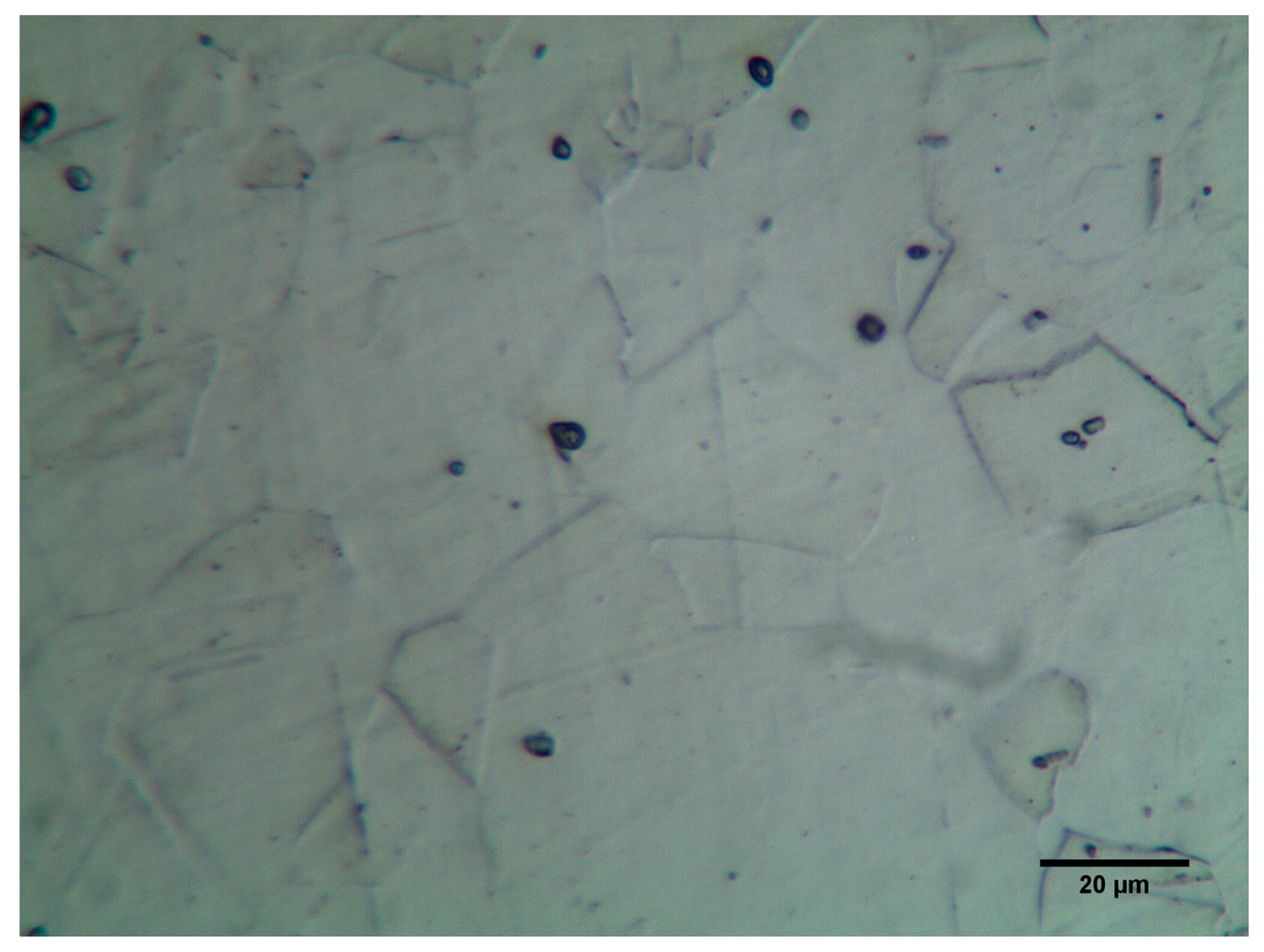

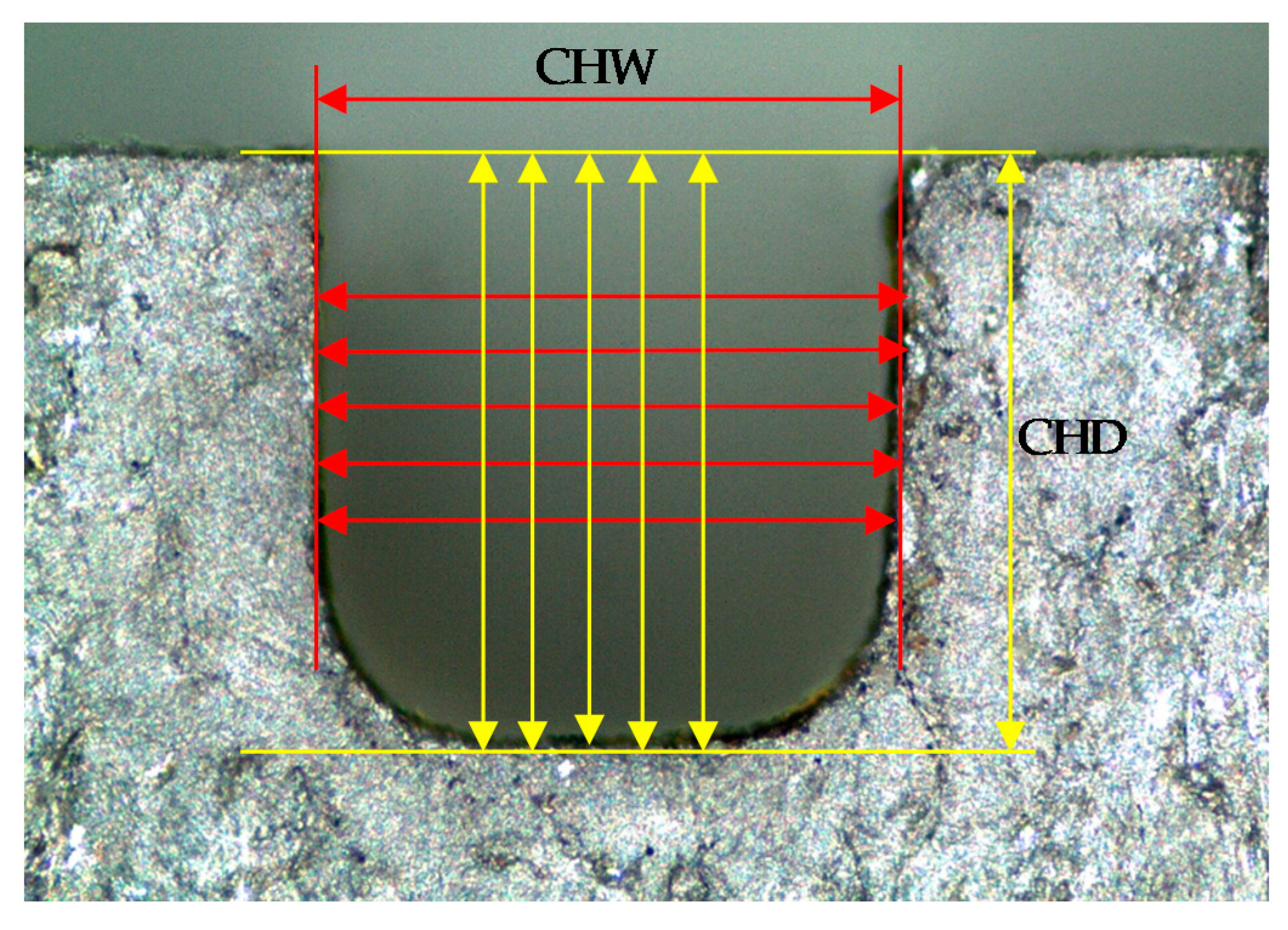
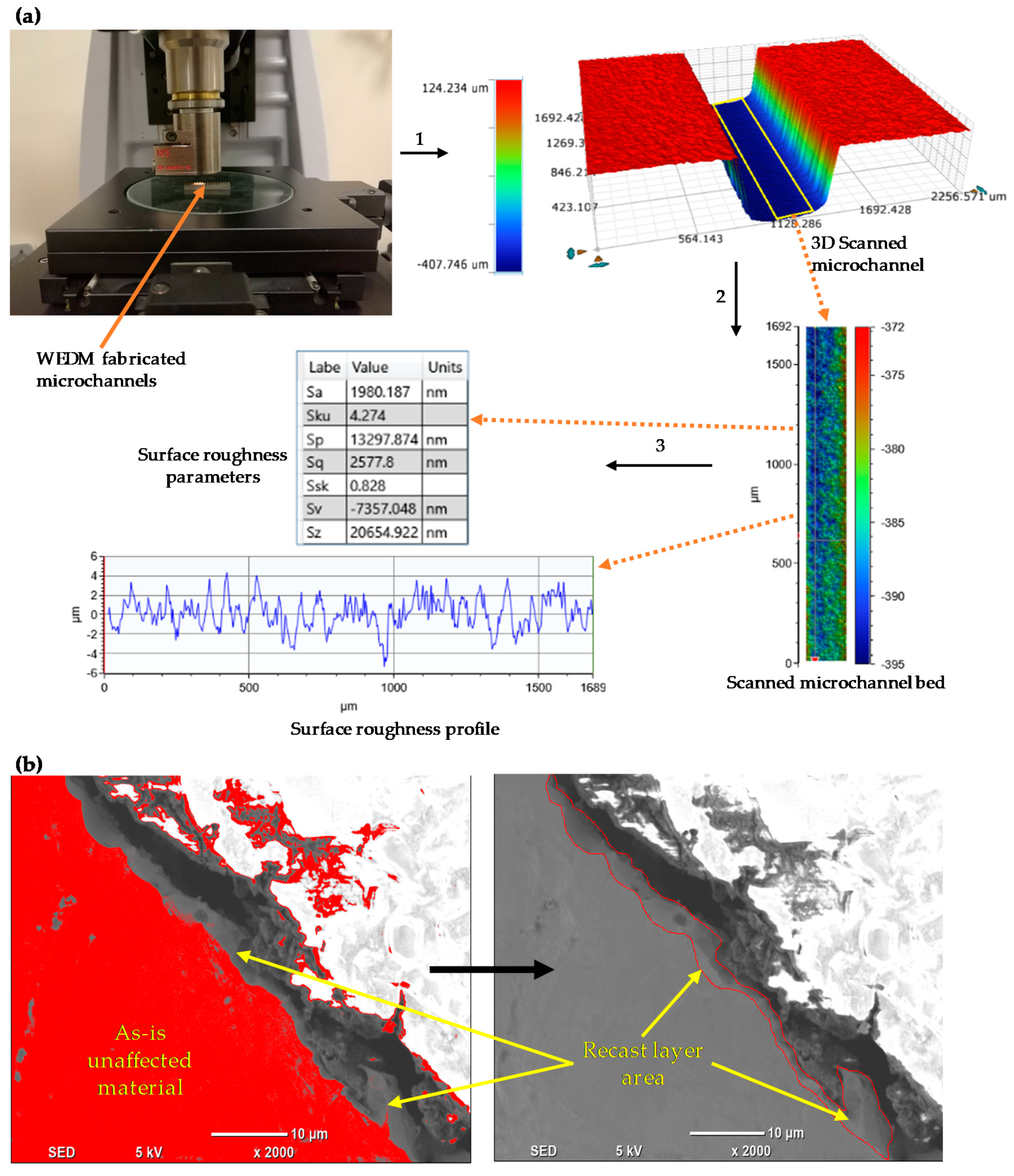
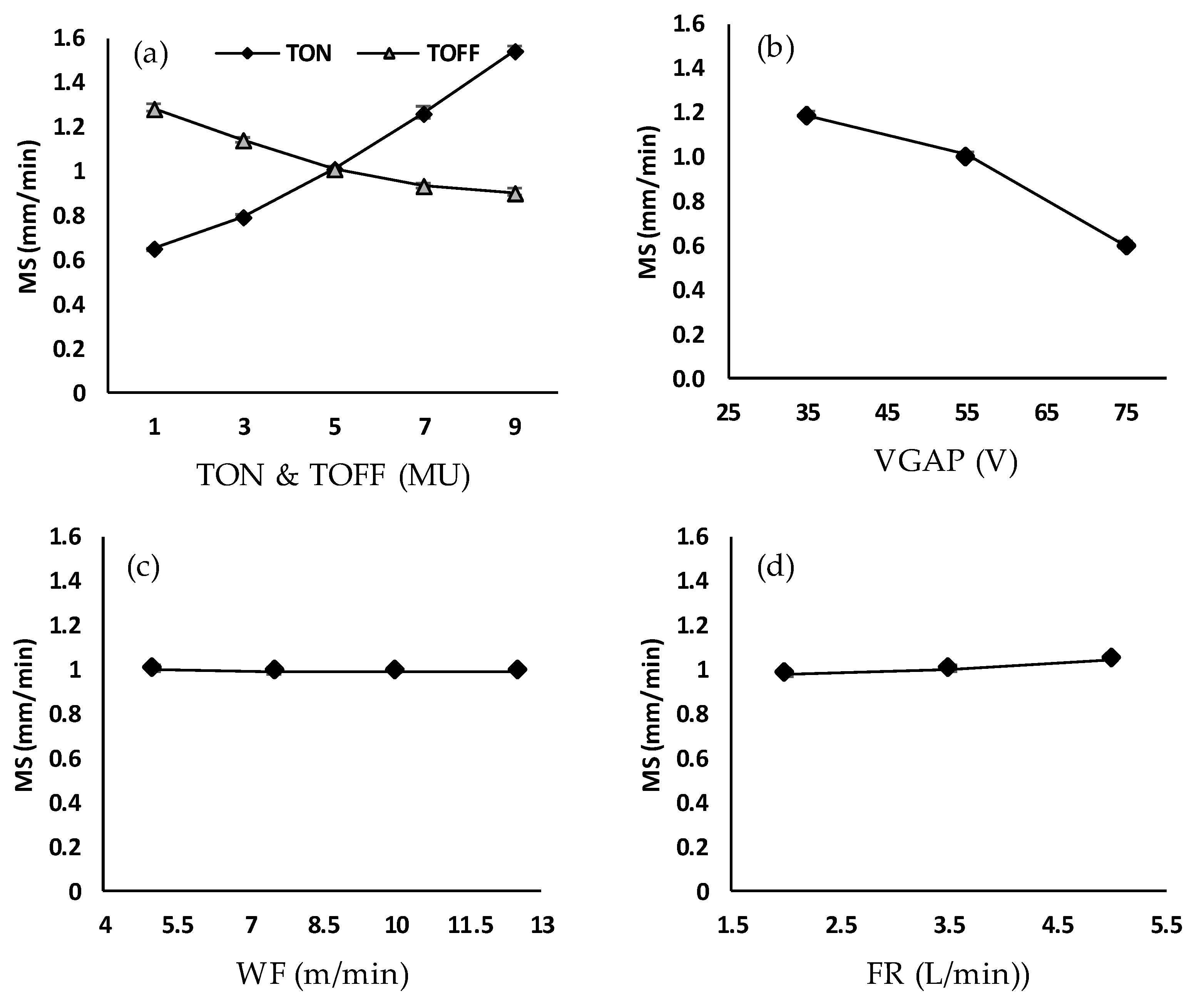


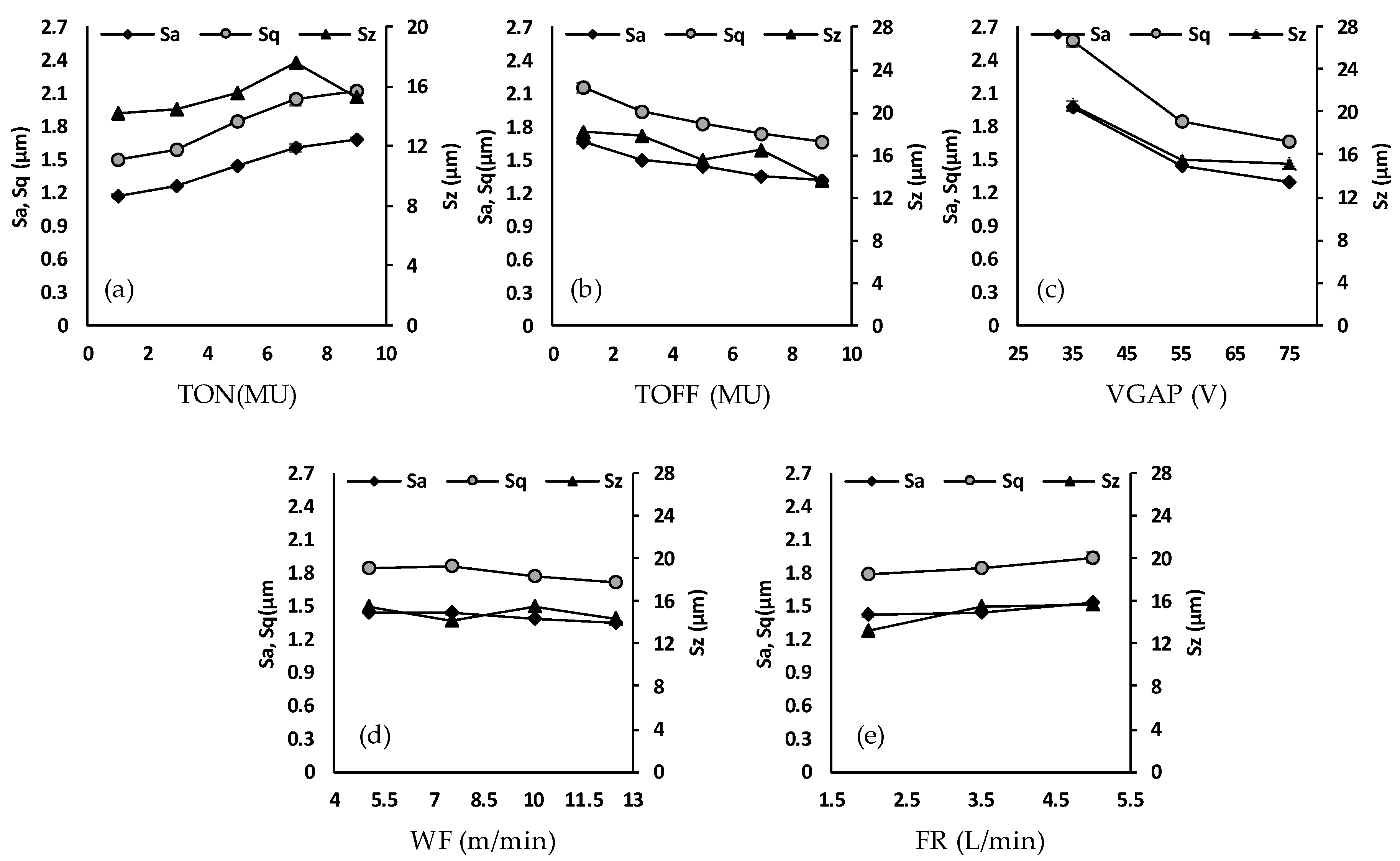


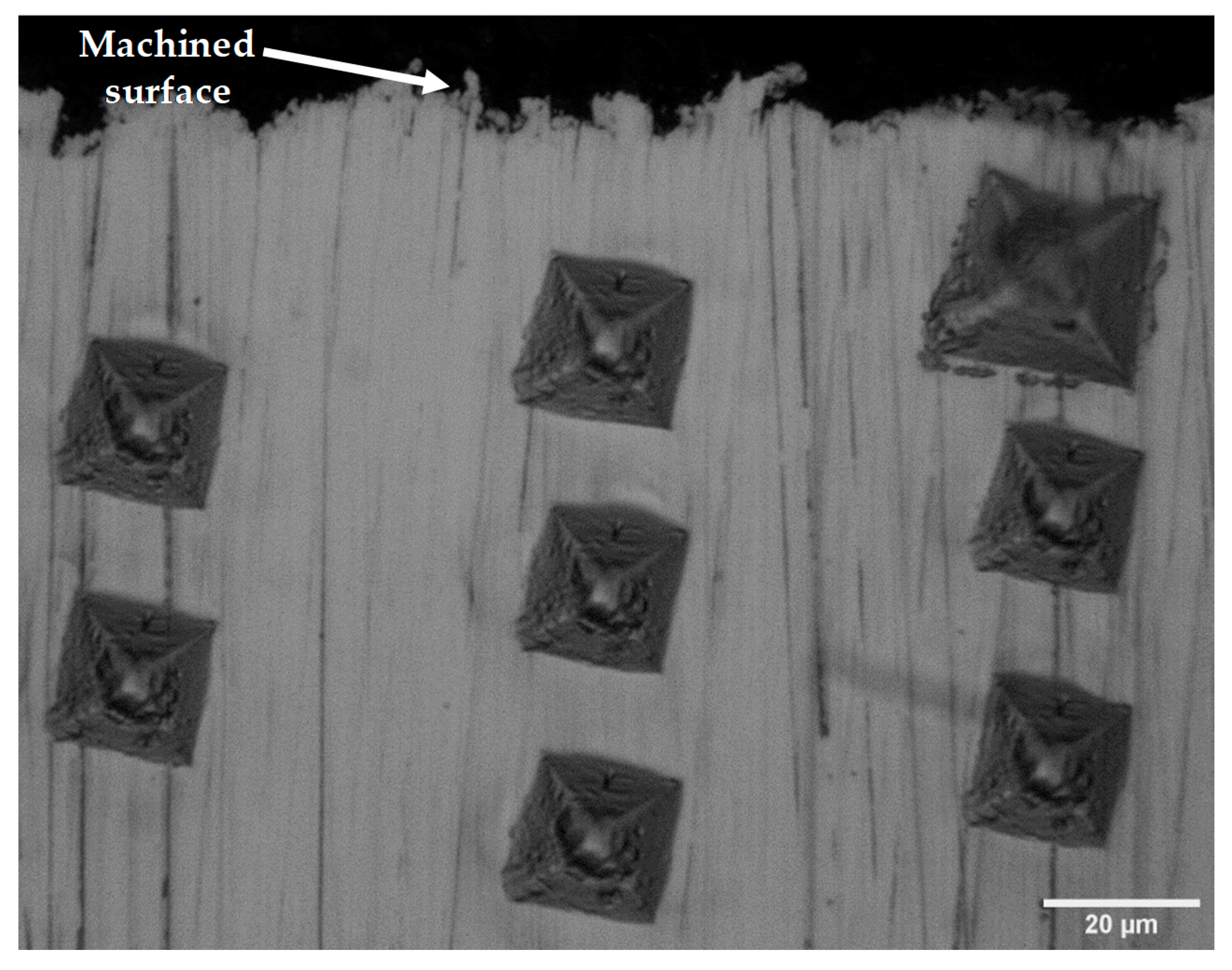


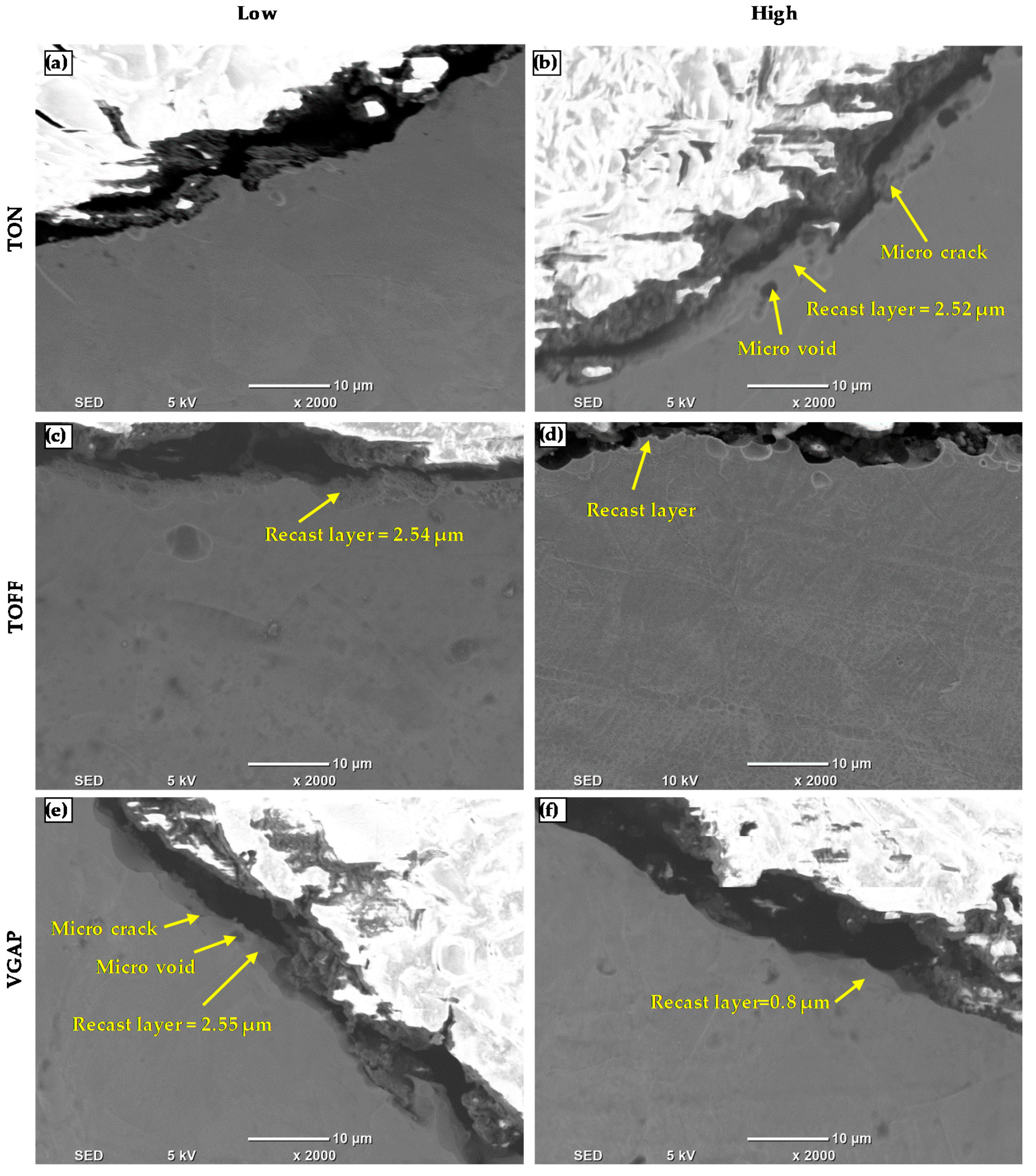
| Composition | C | Si | Mn | S | Cu | Fe | Ni | Co |
|---|---|---|---|---|---|---|---|---|
| Weight % | 0.12 | 0.1 | 1.0 | 0.00 | 32.6 | 2.0 | 64.1 | 0.04 |
| Property | Value | Unit | Property | Value | Unit |
|---|---|---|---|---|---|
| Yield strength | 313 | MPA | Thermal conductivity | 21.8 | W/(m·K) |
| Tensile strength | 565 | MPA | Electric Resistivity | 54.7 × 10−8 | Ohm·m |
| Density | 8.8 | g/cm3 | Coefficient of thermal expansion | 13.9 × 10−6 | °C−1 |
| Melting point | 1350 | °C | Specific heat capacity | 427 | J/(kg·K) |
| Factors | Levels | ||||
|---|---|---|---|---|---|
| Pulse-on time TON, Machine Unit MU (equivalent microseconds) | 1 (10) | 3 (16.667) | 5 (23.333) | 7 (30) | 9 (36.667) |
| Pulse-off time TOFF, Machine Unit MU (equivalent microseconds) | 1 (25) | 3 (41.667) | 5 (58.333) | 7 (75) | 9 (91.667) |
| Average gap voltage VGAP (V) | 35 | 55 | 75 | ||
| Wire feed WF (m/min) | 5 | 7.5 | 10 | 12.5 | |
| Dielectric flow rate DF (L/min) | 2 | 3.5 | 5 | ||
© 2020 by the authors. Licensee MDPI, Basel, Switzerland. This article is an open access article distributed under the terms and conditions of the Creative Commons Attribution (CC BY) license (http://creativecommons.org/licenses/by/4.0/).
Share and Cite
Saleh, M.; Anwar, S.; El-Tamimi, A.; Khan Mohammed, M.; Ahmad, S. Milling Microchannels in Monel 400 Alloy by Wire EDM: An Experimental Analysis. Micromachines 2020, 11, 469. https://doi.org/10.3390/mi11050469
Saleh M, Anwar S, El-Tamimi A, Khan Mohammed M, Ahmad S. Milling Microchannels in Monel 400 Alloy by Wire EDM: An Experimental Analysis. Micromachines. 2020; 11(5):469. https://doi.org/10.3390/mi11050469
Chicago/Turabian StyleSaleh, Mustafa, Saqib Anwar, Abdualziz El-Tamimi, Muneer Khan Mohammed, and Shafiq Ahmad. 2020. "Milling Microchannels in Monel 400 Alloy by Wire EDM: An Experimental Analysis" Micromachines 11, no. 5: 469. https://doi.org/10.3390/mi11050469
APA StyleSaleh, M., Anwar, S., El-Tamimi, A., Khan Mohammed, M., & Ahmad, S. (2020). Milling Microchannels in Monel 400 Alloy by Wire EDM: An Experimental Analysis. Micromachines, 11(5), 469. https://doi.org/10.3390/mi11050469







